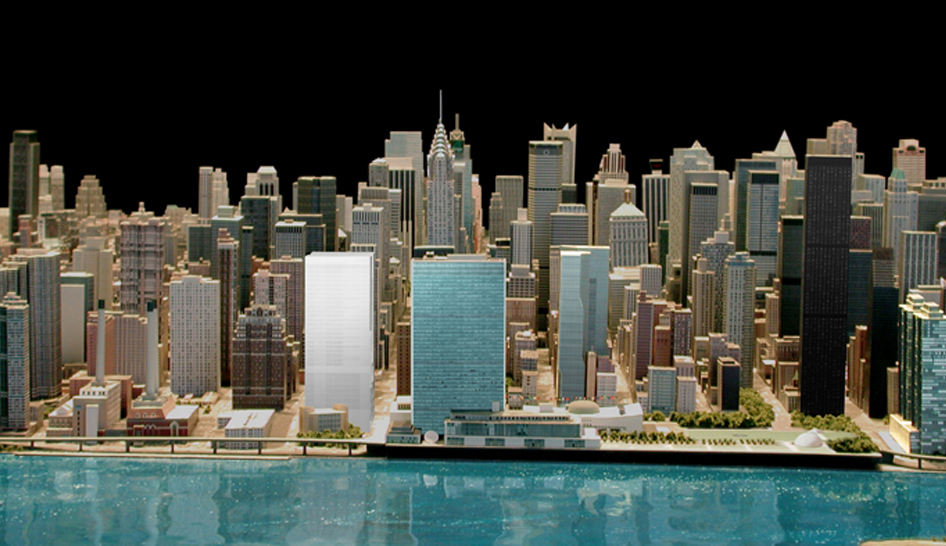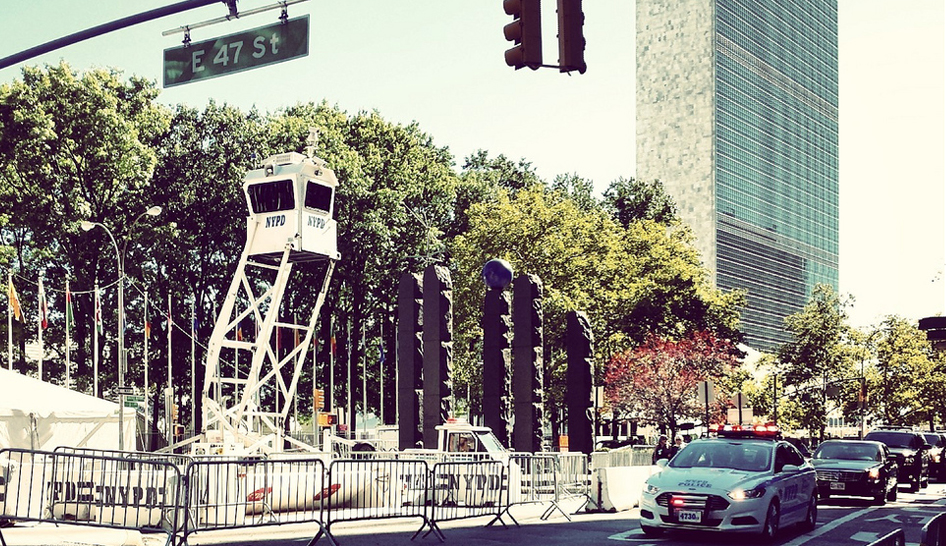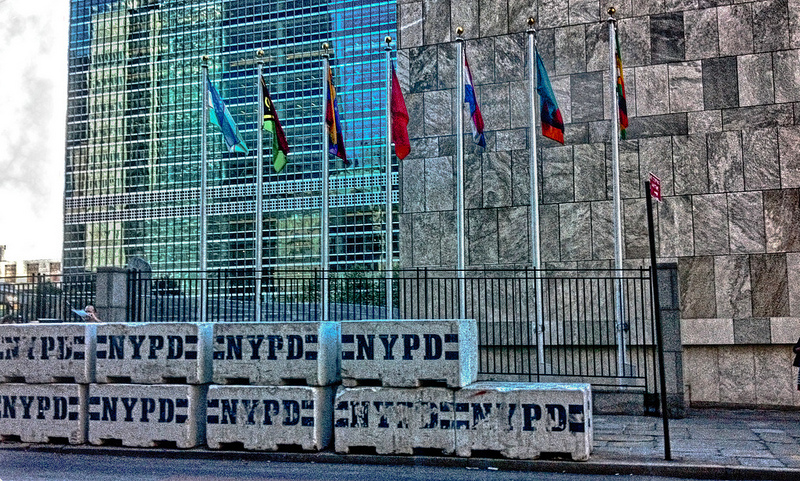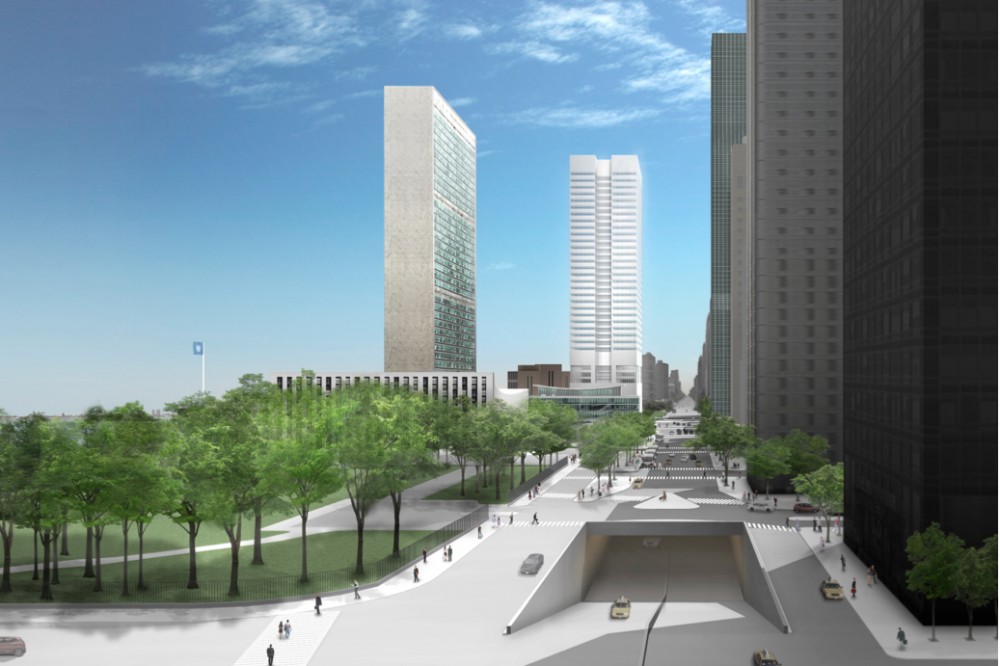As the United Nations wrapped up its 68th General Assembly last week, a major piece of news nearly slipped under the radar: Designs for the UN Consolidation Tower, a 36-storey building that will flank the headquarters like an eager little brother, housing almost 3000 employees. But besides offering much-needed emergency overflow space, this new building could end up making the UN more secure as a whole.
Designed by Japanese architect Fumihiko Maki, who will collaborate with local firm FXFowle on the project, the building is still in very early design development — a vague grey tower that looks to mimic the basic proportions of the original UN. Sited directly south of Le Corbusier and Oscar Niemeyer’s original complex (and connected to it through an underground tunnel), the building will sit on land currently occupied by the Robert Moses Playground. It’s scheduled for completion in 2018 — a tight time frame, for a tower in Manhattan that will house some of the more security-sensitive spaces in the city.

What’s more, the building will be displacing a swath of public space that represents an un-securable threat to the current complex. Like a jetty or a security fence, the new tower will provide a thicker barrier between the chaos of New York City and the carefully-controlled ecology of the UN.

The NYPD presence at the General Assembly. Image by the United Nations Information Centres.
A Potential Command Center
Right now, a cadre of 17 state and federal offices in charge of security during General Assemblies. The coalition — made up of the CIA, the NYPD, and other organisations — is charged with monitoring more than two thirds of the world’s leaders as they move through one of the densest, most difficult cities in the world to secure. According to a rare behind-the-scenes look into the proceedings published in 2011 on The Atlantic, the process is nothing short of a logistical nightmare.
The Secret Service operates out of temporary command posts located elsewhere in the city, where they monitor attendees and evaluate potential threats. Plenty of the planning process takes place during the months leading up the Assembly, too, as security team concocts dozens of crisis scenarios and develops corresponding evacuation plans — no small chore, on this traffic-clogged island.
Though the UN was unable to comment on how the new tower will be used by security personnel, it seems likely that it will give this small army of police officers and agents another command center from which to oversee events.

NYPD barriers outside of the UN. Image by Roman Iakoubtchi
Escape From New York
“One of the things we know is that when things go wrong, we’ve got to get 150 world leaders and their spouses off the island in a hurry,” a special agent in charge of the Secret Service field office told The Atlantic two years ago. That means securing safe houses, helipads and routes out of the city — of which there are few enough:

But evacuation is just the ideal scenario. In the event of a crisis, odds are good that the UN’s “precious cargo” could be stuck in Manhattan, either cut-off from escape routes or under siege in some form. A 2006 report (PDF) on the country’s most difficult-to-evacuate cities gave New York an “F,” ranking it 35th out of 37 cities in total. That’s mainly thanks to the city’s warren of bridges and tunnels, snarled traffic routes, and dense layering of public and private space. Security forces also plan for what will happen if world leaders are stuck in New Amsterdam — for instance, by preparing a medical team led by trauma expert Dr. Maurizio Miglietta that’s ready to perform complex operations on-site if needed.
In that scenario, Consolidation Tower could become a port in a storm, serving as a much-needed command and communications base for security forces in the event of a crisis. Its underground tunnel would be a means of shuttling leaders from the UN to the more secure new building. What’s more, the tower will sit directly above the Queens-Midtown tunnel — one of the more dependable routes off the island.

The UN’s telecommunications satellite dish. Image by United Nations Photo.
Defence Mechanisms
The current building also has its environmental shortcomings. In 2010, the UN was evacuated during a General Assembly because of a “suspicious smell,” which turned out to be sewage overflow from the East River. Around the same time, a $US2 billion renovation of the building got underway, aimed at improving the building’s energy efficiency as well as remove asbestos that dated from the 1960s.
There was also another important reason behind the overhaul: To strengthen the ageing building’s defenses against attack. Workers installed new, blast-proof glass along the sweeping facade of the Secretariat Building (the tall, wide one) which is now capable of deforming up to 25cm without shattering — they also no longer open. That’s a step in the right direction, though it’s still not as ideal as building something suited to the needs of the UN from scratch. Though it’s still early days, the Consolidation Tower will likely be a model for super-secure buildings all over the world when it opens in five years.
In a way, it’s a melancholy development: When a coalition of International Style architects designed the original complex on land donated by John D. Rockefeller, the UN represented the optimism and idealism of the post-War world. And its design reflects that: Smack dab in the middle of Manhattan, fully transparent, and swathed in welcoming parklands. Much has changed in the near 70 years since then, and this new building is bound to reflect that — helping to transform the UN from an open assembly to a secure citadel.
Thus, the UN is stuck in the unenviable position of either being open and transparent, as its mission statement declares (and thus open to attack), or fortress-like and inaccessible, against all that it stands for (and thus more likely to survive an emergency).

